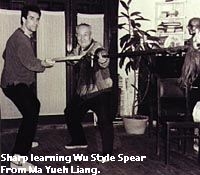Basically, there are five major styles of T'ai Chi Ch'uan, all of which are often viewed as having branched from one of them, the Chen style of T'ai Chi Ch'uan. Except for Chen, the other four styles were primarily influenced or based on the teachings of Yang Luchan. The Yang Style was started by Yang Luchuan when he began to teach Wu Yuxian who later started the Wu/Hao style. The Sun style branched from Wu/Hao style when Hao Weizhen taught Sun Lutang who synthesized, to a certain degree, the Hao style with Baguazhang and Xingyiquan. The Wu (Chian Chuan) style branched from the Yang style when Wu Quan You developed a combative, fast form based on his studies with Yang Luchan and his son, Yang Banhou.
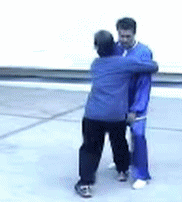
An Overview of T'ai Chi Ch'uan (Taijiquan) - A Brief Comparison of Styles
by Gerald A. SharpLEFT: One of many different possible applications of Wu Style's "White Stork Flaps Its Wings" (Fast Set). Additional T'ai Chi applications and other internal Chinese martial arts can be found on our Applications page.
See the Taijiquan Origins page to read more about the development of T'ai Chi Ch'uan.
T'ai Chi Ch'uan as a class of Nei Jia Internal Kung Fu
Taijiquan (T'ai Chi Ch'uan or Tai Chi Chuan) is a branch of the traditional internal martial arts (or Nei Jia Kung Fu) that spread widely in China over 300 years ago at the beginning of the Qing Dynasty. It became even more popular around 1911, starting in Beijing. Stories abound about how it may have developed around the eighth century. There are many legends that surround the origins of Tai Chi Chuan.
The Internal family of Chinese Martial Arts (or Nei Jia Kung Fu) is described elsewhere in this web site. This group includes three major styles: Taijiquan, Xingyiquan (Hsing I Ch'uan), and Baguazhang (Pa Kua Chang). The group is also associated with Taoist practices.
According to the famous Wu style Taijiquan teacher Ma Yueh Liang, Taichichuan is characterized by: (1) overcoming hard, energetic, dead, gan force with soft, flexibile, movable, rou force; (2) dealing with an opponent's offense with calm "audible strength;" (3) defeating a stronger opponent by employing greater skill; and (4) using retreat in order to advance.
Origins of Taijiquan
Some practitioners both inside and outside of China give credit to Zhang Sanfeng (aka: Zhang Junbao), a wandering 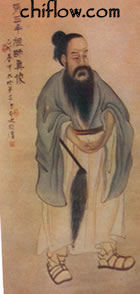 Taoist priest from Wudang Mountain, who during the Yuan Dynasty (15th Century) supposedly developed a gentle, sophisticated art, while watching hard style monks practicing their martial arts on Wudang mountain. However, despite the possibility Zhang did create T'ai Chi, this claim is based on hearsay at best. To date, no concrete evidence exists to prove this person practiced boxing skills of any kind, including T'ai Chi. Zhang was rumored to have taught meditation for longevity, but no actual reference to T'ai Chi exists. However, did this meditation for "longevity" include movements, sitting, standing? Yet another account claims there was an alchemist (also from Wudang mountain) named Zhang Shanfeng who developed Taijiquan during the Song Dynasty (12th Century). Xu Xuanping, a wizard during the Tang Dynasty (8th Century) is also recognized as a potential forbearer of the art. However, while most accounts give credit to the Taoist sojourner, Zhang Shanfeng as the father of Taijiquan, research by both the martial arts master, Tang Hao (1897 - 1959) during the 1930's and historical records from Wen and Anping Counties (as well as historical documents from the Ming Dynasty) indicate that the first known practitioner of Taijiquan was Chen Wangting and not the legendary Zhang Sanfeng.
Although, due to the work of Wang Zongyue, the legend of Zhang Sanfeng cannot be completely dismissed.
Taoist priest from Wudang Mountain, who during the Yuan Dynasty (15th Century) supposedly developed a gentle, sophisticated art, while watching hard style monks practicing their martial arts on Wudang mountain. However, despite the possibility Zhang did create T'ai Chi, this claim is based on hearsay at best. To date, no concrete evidence exists to prove this person practiced boxing skills of any kind, including T'ai Chi. Zhang was rumored to have taught meditation for longevity, but no actual reference to T'ai Chi exists. However, did this meditation for "longevity" include movements, sitting, standing? Yet another account claims there was an alchemist (also from Wudang mountain) named Zhang Shanfeng who developed Taijiquan during the Song Dynasty (12th Century). Xu Xuanping, a wizard during the Tang Dynasty (8th Century) is also recognized as a potential forbearer of the art. However, while most accounts give credit to the Taoist sojourner, Zhang Shanfeng as the father of Taijiquan, research by both the martial arts master, Tang Hao (1897 - 1959) during the 1930's and historical records from Wen and Anping Counties (as well as historical documents from the Ming Dynasty) indicate that the first known practitioner of Taijiquan was Chen Wangting and not the legendary Zhang Sanfeng.
Although, due to the work of Wang Zongyue, the legend of Zhang Sanfeng cannot be completely dismissed.
The only concrete evidence that exists in any historical records is that in 1644, Chen Wangting developed T'ai Chi based on his martial and military skills, which he is chronicled to have led troops to beat back assaulting bandits about twenty years after the overthrow of the Ming Dynasty, in the 1660s, after order was restored during this time, it is said Chen Wangting, influenced by Taoist philosophy, retreated from the world, and began to explore the essence of energy and strength and developed the T'ai Chi Ch'uan hand and weapons sets of the Chen Family. Based on historical documents, it's reasonable to question Jiang Fa teaching the Chen Family, but Wang Zongyue, living about a hundred years before Jiang Fa does leave a question mark on the history of T'ai Chi with the profound text he left on T'ai Chi principles. Despite being Chen's servant it is still possible that Jiang Fa did teach Chen Wangting, despite the lack of written proof. So, despite the research conducted most aptly by Gu Liu Xin, a student of Chen Fake (and the Yang family as well) the questions about the creation or development of T'ai Chi leave more questions than answers, and, as such, even rumors cannot be completely be dismissed at the present time. Regardless, Chen Wangting continued to refine the Chen Style of T'ai Chi until his passing. He is said to have practiced internal boxing to avoid depression, involving himself in field work in the appropriate season, and spending his leisure time teaching disciples and his grandchildren so that they could be contributing members of society.
Click here to go to the Tai Chi Origins Page
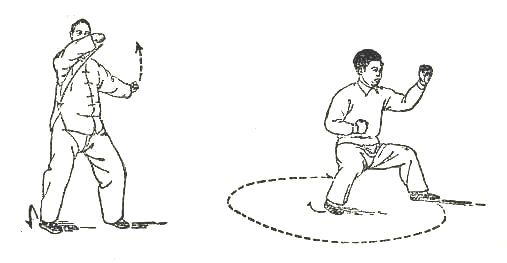
Other arguments for styles attributed to Wudang practitioners prior to Zhang Shanfeng still exist both inside and outside of China. Supporting one side of this argument, there are practitioners of Zhao Bao style Taijiquan (similar looking to Chen) who claim they are doing the original frame, and the Chen Style developed from their cannon. On the other side of this argument, Chen style proponents claim that Zhao Bao developed from the 14th generation Chen family stylist, Chen Youbeng's new style of Taijiquan.
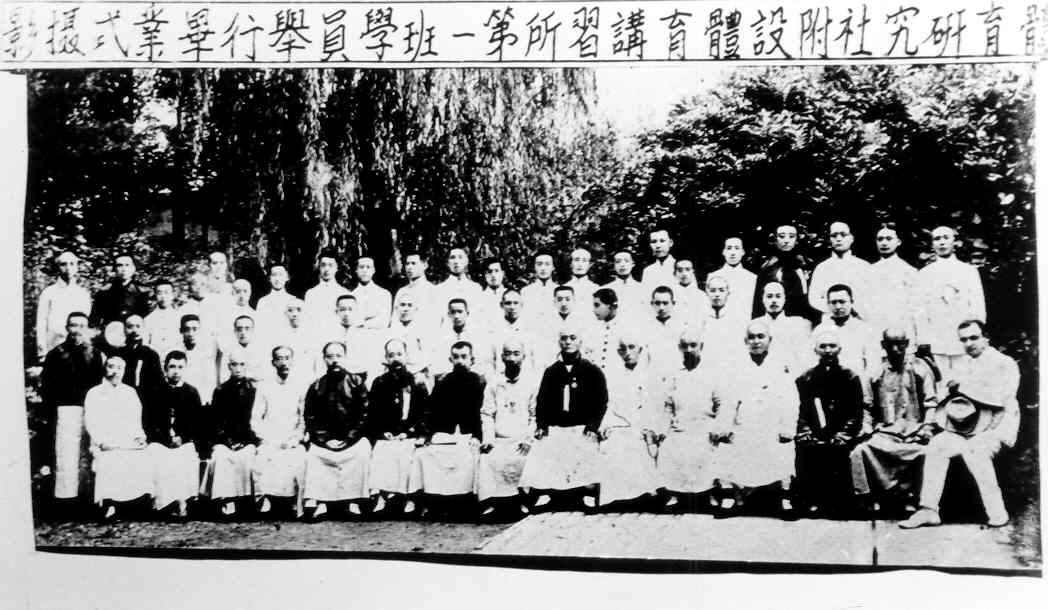
Beijing Physical Culture Association, 1919. Seventh from right, first row is Wu Chian Chuan. Sitting, far right is Mr. Williams, first American to study T'ai Chi in China. Sixth from right, 2nd row is Wu Kung Yi, son of Wu Chian Chuan. 8th from right, 2nd row is Ma Yueh Liang. 4th from left, 3 row is Wu Kung Zhao, also a son of Chian Chuan, who compiled one of the foremost texts on Wu Style in Chinese, "T'ai Chi Boxing Explained" which discusses what is thought to be T'ai Chi's original name and concept, "Ba Me, Wu Bu" (Eight Doors, Five Steps). This text is a commentary on (and including the text) on Yang Banhou's insightful treatise, "T'ai Chi Principles Explained." This rare picture is from the time period when Taijiquan became a publicly practiced art.
|
1. Chen Style
Chen Wangting a ninth generation family member of the Chen Family is credited with having originated Chen Family Style Taijiquan around 1644 (three years before the fall of the Ming Dynasty). It is said by some that the Chen family practiced martial arts prior to Chen Wangting, and others say that earlier Chen family members came up with Tai Chi Chuan. However, no written records exist concerning the Chen family and Taijiquan prior to Chen Wangting. Wangting based part of the development of his unique brand of internal martial arts on 32 forms created by a prominent martial arts master by the name of Qi Jiguang (who lived some 50 years earlier). Chen also borrowed ideas and techniques from Daoyin (exercises that emphasized the exertion of inner force) and Tuna (deep breathing exercises). Unique to the seven sets he would develop were the silk reeling, twisting character of the movements that appeared to onlookers as being more smooth and graceful compared to other martial arts of the time. It is said he also developed methods of pushing hands practice, in which the practitioners practiced twining and sticking to each other to sharpen their sense of touch. Techniques such as catching, take downs, and striking were incorporated in the training. Chen also took the idea of sticking to from pushing hands a step beyond with his development of “sticky spears” training which encouraged students to hide firmness within softness. Thereby, carrying these unique ideas not only into hand to hand combat but into weapons practice as well. At the time, this was seen as a technological advancement in weapon's usage, as guns had not yet been introduced. |
2. Yang Style Yang Luchan, the creator of Yang style, studied with Chen Changxing in Chen family village for a combined 18 years of study before he developed the most popular style of Ta\'i Chi Ch\'uan known as Yang style Ta\'i Chi Ch\'uan. He passed the style to his sons Yang Jianhou and Yang Banhou. Banhou promoted a small frame rendering of the system, while Jianhou focused on a medium frame. Jianhou passed the system onto his sons Yang Shouhou and Yang Cheng Fu (Zhenfu) who were asked to teach Ta\'i Chi Chuan in Beijing at the Physical Culture Association around 1911. Yang Cheng Fu would go onto teach Yang style and develop and promote a big frame of the style. He would pass the system onto his nephew Fu Zhong Wen, a top student named Dong Yinjie and Yang Cheng Fu's sons. The younger son, Yang Zhenduo, is thought to be the top lineage holder of the fourth generation. Although, very likely, he studied more from his brothers and Fu Zhong Wen, since his father passed away when Yang Zhenduo was ten years of age.
|
|
3. Wu (Hao) Style The Wu Yuxian style, also referred to as Hao, was created by Wu Yuxian, a scholar and nobleman from Yongnian County (where the Yang family have roots). In fact, Wu Yuxian and his brothers first studied Ta'i Chi Ch'uan with Yang Luchan when he first started offering classes in Yongnian County, China. Wu Yuxian would go on to study with another Chen family member, Chen Ching Ping. Chen Ching Ping was known for his expertise in small frame style, and he passed intricate knowledge on to Wu Yuxian. Wu Yuxian was also influenced by a rare book his brother gave him on the principles of Ta\'i Chi Ch\'uan entitled, "Ta\'i Chi Ch\'uan Theories," by Wang Zong Yue. Together, with what he learned from Yang Luchan and Chen Ching Ping, Wu was able to assimilate an enormous amount of knowledge about T\'ai Chi Ch\'uan, because the principles in the book seemed to reinforce what he had previously been exposed to. It is said that, at the time, Wu Yuxian became one of the foremost exponents of T\'ai Chi Ch\'uan, regardless of style. Wu Yuxian passed on the mantle to his nephew, Li Yi Yu, in the form of a written treatise called, "The Theories of Thirteen Postures." He wrote two copies by hand, and sent one to Yang Luchan and the other he gave to Li Yi Yu. Li would later pass the system to Hao Weizhen. Hao was so powerful and legendary that many people referred to the style from then on as the Hao style. Hao Weizhen passed on the style to his son Hao Yueh Ru, who in turn passed on the system to Hao Shao Ru who became the subject of drawings used to depict the style in books in China in the late 1950\\'s and early 1960's. Hao Shao Ru passed on the mantle to his adopted son Wang Mu Yin, and giving him the name, Hao Yin Ru. 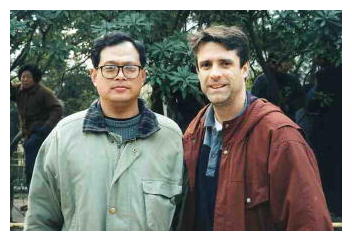
Gerald A. Sharp, right with Wang Mu Yin (Hao Yin Ru) in People\\'s Park, Shanghai, Spring, 1998.
|
4. Wu (Jian Qian) Style
Yang Luchan and Yang Banhou would both teach a Manchurian named Chuan You. Chuan You developed a small frame, combative form which later would serve as the vehicle by which his son, Wu Chian Chuan would develop a slow set and a system of Ta\'i Chi Ch\'uan known as the Wu style. (The similarity of the English translations of he names can obscure the fact that this Wu style of T'ai Chi founded by Wu Chian Chuan is different from the Wu Yuxian, or Hao style of Tai Chi.)
Animated Image: Wu Style Transition to Single Whip application. Wu Chian Chuan taught Ta\'i Chi in Beijing beginning around 1911 with Yang Shouhou and Yang Cheng Fu at the Physical Culture Association. In Beijing, the small frame Wu Chian Chuan taught would become known as the Wu style. Wu Chian Chuan passed it onto his children Wu Gong Yi, Wu Gong Zao, Wu Ying Hua, and his son-in law Ma Yueh Liang. (Ma Yueh Liang was featured in the Bill Moyer's documentary, "Healing And The Mind.") Wu Chian Chuan moved to Shanghai and taught there until his passing. His son, Wu Gong Zao published his father's treatise on T'ai Chi Ch'uan with notes, entitled, "Ba Men Wu Bu" (or, Eight Doors, Five Steps). |
|
5. Sun Style The Sun style of Taijiquan was created by Sun Lutang, a highly influential internal martial arts master and author. Sun had studied Xingyi with Guo Yun Shen and Bagua with Cheng Ting Hua before he encountered Hao Weizhen from whom he studied Taiji. Sun combined the principles of these three arts, which he felt were the same, into one creating Sun Style Taijiquan. He is credited with having promoted (or rediscovered) the concept of Nei Jia Kung Fu at the turn of the 20th century.
|
6. Other Nei Jia Taijiquan Styles While Sun Lu Tang popularized Nei Jia Kung Fu at the turn of the 20th century, it is unlikely that he was the originator of the concept of combining the various internal martial arts into one. Other masters both before Sun's time and after also developed their own Taiji or fusion of internal styles into one. However, ther's no question both Sun and his teachers inspired many internal arts masters of the time to share and create a variety of styles and spin-offs. Consider another prominent student of Guo Yun Shen, Huang Xiang Zai who created both Yi Quan (I Chuan) and Dachengquan, which is a fusion of Taiji, Xingyi, and Bagua, as well as the practice of Nei Kung and Internal Kung Fu. Another internal martial arts fusion that still survives today is known as, Nei Jia Taiji Zhang Quan (Palm and Fist). This inner door taiji style was originated by Zhang Zao Dong, a student of both Dong Hai Quan (Bagua) and Liu Qi Lan (Xingyi). This style (that combines Bagua, Xingyi, and Old Chen Style Taiji) was later both developed and popularized as an inner door style by Zhang's student, Jiang Rong Qiao. While these styles are powerful fusions like Sun Style, Dachengquan and Nei Jia Taiji Zhang Quan are still considered in some circles to be inner door practices. Unfortunately, because of their secrecy and difficulty in studying, they have not enjoyed the popularity of Sun Style. However, that doesn\'t make them any less beneficial or dynamic. |
|
7. Comparison of the styles of TaichichuanTai Chi styles differ, yet there are some similarities. Chen style combines hard and soft, fast and slow much like the traditional martial Buddhist principles of pumping to develop power and health. Yang style seeks softness and stillness outside with hardness inside. Wu Yuxian (Wu - Hao style) and Sun style utilize a more upright, following step to create and issue power in four stages known as: Starting, Connecting, Opening, and Closing. (Sun Lutang\'s development of Sun style was linked to his learning Wu - Hao style.) The Wu Chian Chuan style utilizes a unique characteristic of leaning and uprightness. Just as energy when standing still rocks back and forth from ball to heel, so the Wu style of Wu Chian Chuan uses the body to extend and collapse from the this natural force in the feet. Although the leaning aspect of Wu style has sometimes been controversial, it is characteristic of the style. What appears to be "leaning forward" combined with the upright stance in movement creates a veritable tidal wave of power in developing strength and Chi.
Photos: (Above) Ma Yueh Liang teaching the Wu style Tai Chi spear to Gerald Sharp at Ma and Wu's home, Autumn, 1992. |
8. Push Hands (Tui Shou) Many styles of Tai Chi, Pa Kua, and Hsing-I utilize similar types of joint hands methods mostly referred to as Push Hands. The names may differ somewhat, and the techniques may as well, but all these methods share some commonalities. This makes the practice of Push Hands a vital and integral part of true internal martial arts training, and a common thread between the many different internal arts; as well as, the many different styles of Ta'i Chi Ch'uan. Whether you see Push Hands training as a two person exercise in developing sensitivity in recognizing your opponent\'s power or center of gravity, heightening communication, or developing Chi, Push Hands is a veritable building block in Ta'i Chi Ch'uan training. The effect of Push Hands practice is that it transforms the solo form's practice into a two person, more interactive understanding of the art. |

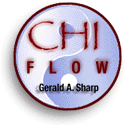


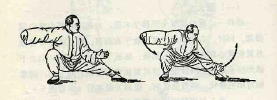
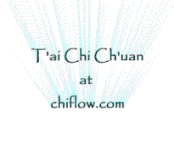
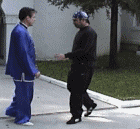 (Left: Wave Hands Like Clouds application from the Wu style Taiji Fast Set, Wu's Original form.)
(Left: Wave Hands Like Clouds application from the Wu style Taiji Fast Set, Wu's Original form.) 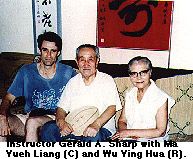
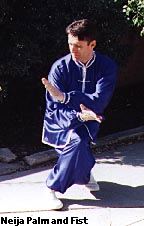 Other contemporary masters of Sun Lutang also combined the essence of internal arts and created internal fist forms forging one complete Nei Jia (Bagua, Xingyi, and Taiji) art. However, few of these styles remain, or are in the public eye with the degree of prominence that Sun Style Taiji has. What really popularized Sun's approach, other than his noted superior skills, was that he published different works on the internal arts including Xingyiquan, The Study of Bagua Boxing, A Study of Taijiquan, The True Essence of Boxing, and Bagua Sword. A Study of Taijiquan outlines the principles of his knowledge of Taijiquan from Hao Weizhen with his fusion of superior insight into Xingyi and Bagua in stark detail. Sun passed the art on primarily to his daughter, Sun Jian Yun.
Other contemporary masters of Sun Lutang also combined the essence of internal arts and created internal fist forms forging one complete Nei Jia (Bagua, Xingyi, and Taiji) art. However, few of these styles remain, or are in the public eye with the degree of prominence that Sun Style Taiji has. What really popularized Sun's approach, other than his noted superior skills, was that he published different works on the internal arts including Xingyiquan, The Study of Bagua Boxing, A Study of Taijiquan, The True Essence of Boxing, and Bagua Sword. A Study of Taijiquan outlines the principles of his knowledge of Taijiquan from Hao Weizhen with his fusion of superior insight into Xingyi and Bagua in stark detail. Sun passed the art on primarily to his daughter, Sun Jian Yun.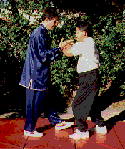 (T'ai Chi Push Hands is a method of training shared amongst styles.)
(T'ai Chi Push Hands is a method of training shared amongst styles.) 